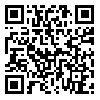قابل توجه نویسندگان محترم، مقالاتی که از تاریخ 1404/07/13 برای نشریه ارسال می شوند، شامل پرداخت هزینه بررسی نخواهند شد.
Volume 8, Issue 1 (Semi-Annual 2024)
JIC 2024, 8(1): 25-38 |
Back to browse issues page
Download citation:
BibTeX | RIS | EndNote | Medlars | ProCite | Reference Manager | RefWorks
Send citation to:



BibTeX | RIS | EndNote | Medlars | ProCite | Reference Manager | RefWorks
Send citation to:
Noori M, Amin Khandaqi J, Fadavi R. (2024). Studying the Structure and Motifs of Contemporary Coin Embroidery in Sistan and Baluchestan. JIC. 8(1), 25-38. doi:10.61186/jic.8.1.304
URL: http://jih-tabriziau.ir/article-1-304-en.html
URL: http://jih-tabriziau.ir/article-1-304-en.html
1- , j.amin@ferdowsmashhad.ac.ir
Abstract: (2625 Views)
The gateway between Indian and Iranian cultures is Baluchestan. The art flourishing in this land is due to its linguistic, cultural, and geographical location. Coin embroidery is a declining art in Sistan and Baluchistan. The art of these women is needlework or coin embroidery, which is an ancient art that has many aesthetic aspects. Symbols are an important part of the currency. Roles are driven primarily by nature and moral concepts. This research examines the art of coin embroidery in Sistan and Baluchistan, which aids in understanding the cultural and ancient dimensions of this region. This research aims to explain and categorize the structure and motifs of coin embroidery in Sistan and Baluchistan. What are the structures and patterns of coin embroidery art in Sistan and Baluchistan? This is the main question. The research's application is descriptive-analytical in terms of type. The library, viewing pictures, and interviews are the ways in which information is collected. The method of analysis is qualitative. The sampling method is selective, and seven samples from the past 50 years have been analyzed. This research shows that geometric motifs are considered the most important aesthetic element of the art of coin embroidery, but it shows that all geometric elements, including line, texture, shape, color, and rhythm, are made by symbolic abstraction, and this abstraction is related to the background of Baloch people's life. And this special aesthetic characteristic of the abstract art of coin embroidery can be considered a kind of identity document for the coin embroidery of Sistan and Baluchistan, which is transferred from the past to the present and the future generations. Baloch coin embroidery motifs have a direct relationship with the life, nature, and the vision of the people of that region, and considering motifs such as stars, suns, and numbers such as 3, 5, 9, 11, etc., it can be concluded that the people of Sistan and Baluchistan are familiar with the science of astronomy. Astronomy is used by them. One of the most widely used geometric motifs in the art of coin embroidery is the circle motif, which creates the original design on the background in the form of round mirrors. The divine truth is expressed through the mirror. The use of proportions and symmetry of motifs such as circles, squares, triangles, and rhombuses is one of the main rules of geometric motifs in the art of coin embroidery, and plant motifs are also formed as abstract designs while maintaining geometric features. Human characters such as eyes, human, man and woman, etc. can be seen in the examples of Sistan and Baluchistan coin embroidery patterns, and human characters do not have a clear resemblance to humans, and in fact, they are called by this name because of their similarity to human characteristics. A symbol such as Konak (fish ear) is one the symbols that refer to the authenticity and identity of the coin, Kochak is obtained from Lake Hamon and has a meaning of white color and expresses purity, innocence and purity, and reminds people that Lake Hamon is sacred. The third largest lake in our country, Hamon, is located in Sistan and Baluchistan, and it has been mentioned numerous times in history, literature, and Avesta. This harmony between geometric motifs, astronomy, nature, abstraction, animal and human motifs with the art of coin embroidering should be attributed to women artists and coin embroiderers who create such roles without any training experimentally and mentally. Other important features of the art of Baloch embroidery are the variety of colours and the multiplicity of colours. The color in this art is formed by colored woolen threads, and in most coin embroidery, the dominant color on the background is almost 80% red and green, and colors such as blue and white are also available in all samples. In the art of coin embroidery, each color has its own rules to follow.
Type of Study: Original Research |
Subject:
2
Received: 2023/10/1 | Accepted: 2024/03/2 | Published: 2025/01/4
Received: 2023/10/1 | Accepted: 2024/03/2 | Published: 2025/01/4
Send email to the article author
| Rights and permissions | |
 |
This work is licensed under a Creative Commons Attribution-NonCommercial 4.0 International License. |






 tabriziau.ac.ir
tabriziau.ac.ir